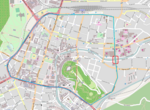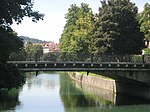The Trail of Remembrance and Comradeship (Slovene: Pot spominov in tovarištva, acronym PST), also referred to as the Trail Along the Wire (Pot ob žici), the Trail Around Ljubljana (Pot okoli Ljubljane), or the Green Ring (Zeleni prstan), is a gravel-paved recreational and memorial walkway almost 33 km (21 mi) long and 4 m (13 ft) wide around the city of Ljubljana, the capital of Slovenia. The walkway leads past Koseze Pond and across Golovec Hill.
During World War II, the Province of Ljubljana, annexed by Fascist Italy, was subjected to brutal repression after the emergence of resistance and the Italian forces erected a barbed wire fence—the route of which is now the Trail of Remembrance and Comradeship—around Ljubljana in order to prevent communication between the city's underground Liberation Front activists in Ljubljana and the Slovene Partisans in the surrounding countryside. The barbed wire was set around the town in February 1942 and surrounded it (even after the town's liberation on 9 May 1945) until 26 June 1945, when the town was visited by Tito.The construction of the trail started in 1974 and was completed in 1985. It is marked by signposts, information boards with the map of the trail, plaques, and metal markers, as well as signposts at the turn-offs. One hundred and two octagonal memorial stones, designed by the architect Vlasto Kopač, have been installed at the former positions of the bunkers. Along the green area adjacent to it, 7,400 trees of 49 tree species have been planted. Since 1988, it has been protected as a designed nature monument.The trail is used by many residents of Ljubljana each day. The most popular form of recreation on it is walking and jogging. Cycling is also permitted on condition that pedestrians are not endangered. During snowy winters, cross-country ski tracks are provided at some of its sections. Each year since 1957, on the weekend closest to 9 May, the traditional recreational March along the Wire (Pohod ob Žici; it held several names since its beginning) takes place to mark the liberation of Ljubljana on 9 May 1945. Those who walk the entire distance and collect stamps at all eight checkpoints receive a memorial badge and a medal.
Because of Ljubljana's growth over the years, some areas of the path now pass through built-up areas. Examples include the segment from Koseze crossing Klagenfurt Street (Celovška cesta) and Vienna Street (Dunajska cesta) and ending near Stožice Stadium.











